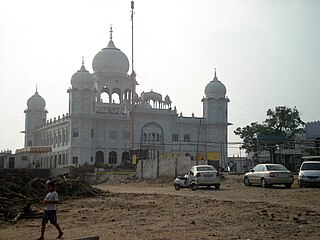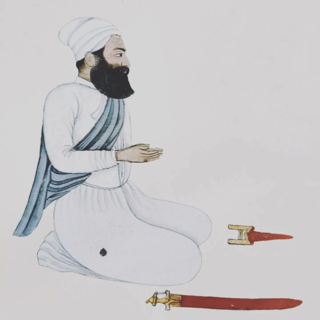
Guru Gobind Singh was the tenth and last human Sikh Guru. He was a warrior, poet, and philosopher. In 1675, at the age of nine he was formally installed as the leader of the Sikhs after his father Guru Tegh Bahadur was executed by Emperor Aurangzeb. His father was the ninth Sikh Guru. His four biological sons died during his lifetime – two in battle and two executed by the Mughal governor Wazir Khan.
Dal Khalsa was the name of the combined military forces of 11 Sikh misls that operated in the 18th century (1748–1799) in the Punjab region. It was established by Nawab Kapur Singh in late 1740s.

Ajit Singh, also referred to with honorifics as Sahibzada Ajit Singh or Baba Ajit Singh, was the eldest son of Guru Gobind Singh and the son of Mata Sundari. His younger brothers were Jujhar Singh, Zorawar Singh and Fateh Singh, but they had been born to Mata Jito. He was killed in the Second Battle of Chamkaur along with his brother Jujhar Singh. His other two brothers, Zorawar Singh and Fateh Singh, nine and seven years old, respectively, were bricked alive at Fatehgarh Sahib on order of Wazir Khan, governor of Sirhind-Fategarh.

Nada Sahib is a Sikh gurudwara in the Panchkula district of the Indian state of Haryana. Situated on the banks of the Ghaggar-Hakra River in the Sivalik Hills of Panchkula, it is the site where Guru Gobind Singh Ji halted while travelling from Paonta Sahib to Anandpur Sahib after the Battle of Bhangani in 1688.
The Battle of Bhangani was fought between Guru Gobind Singh's army and Bhim Chand (Kahlur) of Bilaspur on 18 September 1686 or 1688, at Bhangani near Paonta Sahib. An alliance of Rajput Rajas of the Shivalik Hills participated in the engagement on behalf of Bhim Chand of Bilaspur State's side, including the states of Garhwal and Kangra. It was the first battle Guru Gobind Singh, the tenth Sikh Guru, fought at the age of 19.

The Battle of Nadaun, alternatively known as the Hussaini Yudh, was fought at Nadaun, between Raja Bhim Chand of Bilaspur (Kahlur) and the Mughals under Alif Khan. Bhim Chand was supported by Guru Gobind Singh and the Mughals were supported by other hill chieftains, notably Kirpal Chand from Kangra and Dayal Chand from Bijharwal. Bhim Chand and some hill chieftains, after conclusion of Battle of Bhangani had refused to pay tribute to the Mughal emperor which led to the battle at Nadaun. The battle resulted in the victory of Bilaspur State and Sikh alliance.
The Battle of Anandpur was fought at Anandpur, between the armies of the Sikh Guru Gobind Singh and the Mughal forces aided by the Nawab of Bahawalpur state, Rajas of the Sivalik Hills.

The second siege of Anandpur, also known as the second battle of Anandpur (1704), was a siege at Anandpur, between Sikhs and the Mughal governors, dispatched by Aurangzeb, Wazir Khan, Dilwaar Kahn and Zaberdast Khan, and aided by the vassal Rajas of the Sivalik Hills which lasted from May 1704 to 19 December 1704.
Battle of Anandpur can refer to:
The first siege of Anandpur was a thirty-five-day-long siege at Anandpur led by the Rajas of the Sivalik Hills and the Gujar and Ranghar tribesmen against the armies of the Sikh under Guru Gobind Singh.
The Battle of Guler was fought between forces led by Sikh Guru Gobind Singh and Mughal forces, aided by the Rajas of the Sivalik Hills.

Bhim Chand was the Rajput King of Bilaspur state and Anandpur Sahib fell under his territorial area. He launched his first expedition against Guru Gobind Singh in 1682. In 1686 he conflicted with the armies of Guru Gobind Singh and his disciples in Battle of Bhangani. In 1692, Bhim Chand fought Battle of Nadaun against Mughals and came out victorious.
The First battle of Chamkaur was fought in 1702 between the Sikhs and the Mughals. It resulted in a Sikh victory and the Mughal General Sayyad Beg joining the Sikhs with some troops.

The Hill States–Sikh wars, also known as the Sikh–Pahari Raja wars, was a set of battles and conflicts fought by the Sikhs and the rajas (kings) of the Hill States located in the Sivalik Hills.
The Battle of Anandpur was fought between the Sikh forces led by Guru Gobind Singh and the Hill State forces by Alim and Balia Chand. This was the first major battle fought after the formation of the Khalsa.

Alam Singh Nachna, also called Alim Singh, was a warrior in the army of Guru Gobind Singh, and was a Rajput turned Sikh. Sarup Das Bhalla of Mahima Prakash describes him as one of Guru Gobind Singh's constant and closest companions. He is also known for killing a lion single handedly.
The Battle of Anandpur was fought on 24 February between the Sikh forces led by Guru Gobind Singh and the forces of some Hill States.
The Battle of Bilaspur was fought in 1711 by Sikh forces led by Banda Singh Bahadur and the rulers of the Sivalik Hills led by Raja Ajmer Chand of Princely State of Kahlur (Bilaspur).
Uday Singh was a Sikh warrior during the period of Guru Gobind Singh.
The Battle of Talwara was fought in 1770 by the Sikh forces led by Jassa Singh Ramgarhia and the Kangra forces led by Raja Ghamand Chand.







